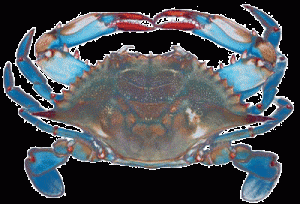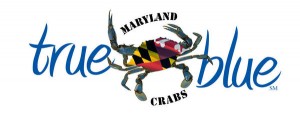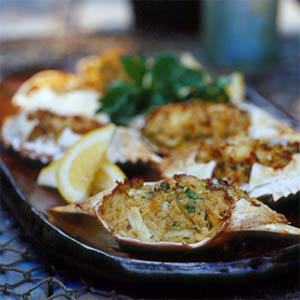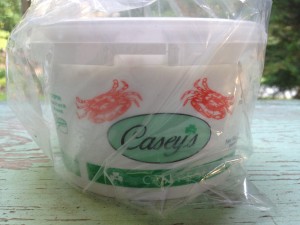I think if you practice your technique, put your love (and pocketbook) into it, then the best, most classic, genre-defining crab cake will come from your kitchen. That crab cake will be the one your loved ones love, the one they ask you to make on special occasions like their birthday, graduations or when they are home on holiday.
Here’s Tom Douglas’s recipe for Chesapeake Bay Classic Crab Cakes (which I have made often and adapted by using Hellman’s mayonnaise instead of making my own and substituting shallots for the scallions):
Chesapeake Bay Classic Crab Cakes
- 1/4 C. good quality mayonnaise (Hellman’s)
- 1 T. Dijon mustard
- 1 T. Old Bay Seasoning
- 1 T. fresh lemon juice
- 1 T. minced shallots, sauteed lightly in 1/4 tsp. of butter
- 5 T. unsalted butter
- 1 pound lump crab meat, drained and picked clean of shell
- 4 C. fresh bread crumbs
- 1/4 C. chopped parsley

Crab cakes dressed for company with sriracha remoulade.
Photo by John Penovich. Food styling by Rebecca Penovich.
Directions
- In a small saute pan over low heat, melt 1 T. unsalted butter. Add the chopped shallot and cook over low heat until shallots have released their water but are not brown. Let cool.
- In a bowl with the mayonnaise, add the 1 T. mustard, 1 T. Old Bay Seasoning, 1 T. fresh lemon juice and fold with a spatula until combined. Add the crab meat to the mayonnaise mixture and fold gently until evenly mixed. Do not break up lumps and do not overmix.
- Place the fresh bread crumbs and chopped parsley in a single layer onto a platter or baking sheet lined with parchment. Gently scoop ½ C. portions of crab mixture and shape into patties. Place the crab cake on the crumbs, and sprinkle crumbs over the top. Turn the cake over and sprinkle with more crumbs. Repeat to make the remaining crab cakes, 10-12 in all. Cover and refrigerate for at least 1 hour or more. (Chef Douglas recommends leaving the formed crab cakes on the platter or baking sheet of crumbs and wrapping the whole thing.)
- In a large nonstick frying pan over medium heat, melt 2 T. of butter. When the butter is melted, gently slide half of the crab cakes into the pan (give them room in order to turn them.) Cook each side until golden brown, about 4 minutes per side. If crab cakes are browning too quickly, reduce the heat. Melt 2 more T. of butter to do the second batch. Keep cakes warm in a low oven.
- Serve with your choice of sauce and lemon wedges.
A Corks & Cake friend, Kay Krogh Gallagher, submitted a comment with her absolute favorite crab cake recipe from the venerable Vidalia restaurant in Washington, DC. Vidalia’s award-winning chef and owner Jeffrey Buben knows a thing or two about regional American cuisine with Southern influence and his version of the crab cake has been on Vidalia’s menu since the restaurant’s opening 20 years ago. It is a top seller.
Vidalia’s recipe is classic on the crab cake spectrum (lump meat, delicate hand, saltines as filler) but calls for 2 tsp. of chopped cilantro which Kay says adds something special.
The following recipe was published in Washingtonian magazine, Recipe Sleuth, Anna Spiegel, July 13, 2011.
Vidalia’s Crabcake
Makes 4
- 1 pound Maryland jumbo-lump crab meat (picked and checked for shell or cartilage)
- 8 saltine crackers, crushed
- 2 teaspoons chopped fresh cilantro
- 1 egg, beaten
- 1 tablespoon Duke’s mayonnaise
- 1 tablespoon unsalted butter at room temperature
- 1 teaspoon Dijon mustard
- ¼ teaspoon Worcestershire sauce
- 1 dash hot-pepper sauce, such as Tabasco
- 3 tablespoons vegetable oil
- Salt and freshly ground pepper to taste
Directions
- In a medium bowl, combine crab meat, saltines, cilantro, salt, and pepper. In a separate bowl, beat together the egg, mayonnaise, butter, mustard, Worcestershire, and hot sauce. Combine that mixture with the crab meat and mix well.
- Shape the mixture into 4 crabcakes and refrigerate for at least 1 hour, and up to 24.
- Heat 3 tablespoons of vegetable oil in a non-stick frying pan over medium-high heat until the oil is hot. Sauté the crabcakes in batches until golden brown on each side, about a total of 3 to 5 minutes. Set on a paper towel momentarily when they’re done.
- Serve immediately, garnish with tartar sauce, a mustard buerre blanc, or other mustard-based sauce.









